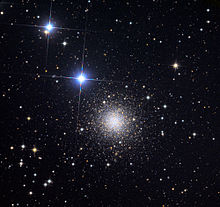
Antlia is a constellation in the Southern Celestial Hemisphere. Its name means "pump" in Latin and Greek; it represents an air pump. Originally Antlia Pneumatica, the constellation was established by Nicolas-Louis de Lacaille in the 18th century. Its non-specific (single-word) name, already in limited use, was preferred by John Herschel then welcomed by the astronomic community which officially accepted this. North of stars forming some of the sails of the ship Argo Navis, Antlia is completely visible from latitudes south of 49 degrees north.

Ara is a southern constellation between Scorpius, Telescopium, Triangulum Australe, and Norma. It was one of the Greek bulk described by the 2nd-century astronomer Ptolemy, and it remains one of the 88 modern constellations designated by the International Astronomical Union.

Corona Borealis is a small constellation in the Northern Celestial Hemisphere. It is one of the 48 constellations listed by the 2nd-century astronomer Ptolemy, and remains one of the 88 modern constellations. Its brightest stars form a semicircular arc. Its Latin name, inspired by its shape, means "northern crown". In classical mythology Corona Borealis generally represented the crown given by the god Dionysus to the Cretan princess Ariadne and set by her in the heavens. Other cultures likened the pattern to a circle of elders, an eagle's nest, a bear's den or a smokehole. Ptolemy also listed a southern counterpart, Corona Australis, with a similar pattern.
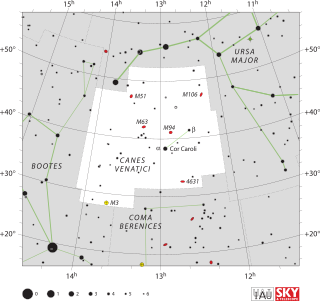
Canes Venatici is one of the 88 constellations designated by the International Astronomical Union (IAU). It is a small northern constellation that was created by Johannes Hevelius in the 17th century. Its name is Latin for 'hunting dogs', and the constellation is often depicted in illustrations as representing the dogs of Boötes the Herdsman, a neighboring constellation.

Fornax is a constellation in the southern celestial hemisphere, partly ringed by the celestial river Eridanus. Its name is Latin for furnace. It was named by French astronomer Nicolas Louis de Lacaille in 1756. Fornax is one of the 88 modern constellations.
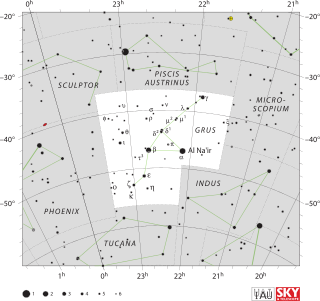
Grus is a constellation in the southern sky. Its name is Latin for the crane, a type of bird. It is one of twelve constellations conceived by Petrus Plancius from the observations of Pieter Dirkszoon Keyser and Frederick de Houtman. Grus first appeared on a 35-centimetre-diameter (14-inch) celestial globe published in 1598 in Amsterdam by Plancius and Jodocus Hondius and was depicted in Johann Bayer's star atlas Uranometria of 1603. French explorer and astronomer Nicolas-Louis de Lacaille gave Bayer designations to its stars in 1756, some of which had been previously considered part of the neighbouring constellation Piscis Austrinus. The constellations Grus, Pavo, Phoenix and Tucana are collectively known as the "Southern Birds".

Microscopium is a minor constellation in the southern celestial hemisphere, one of twelve created in the 18th century by French astronomer Nicolas-Louis de Lacaille and one of several depicting scientific instruments. The name is a Latinised form of the Greek word for microscope. Its stars are faint and hardly visible from most of the non-tropical Northern Hemisphere.

Piscis Austrinus is a constellation in the southern celestial hemisphere. The name is Latin for "the southern fish", in contrast with the larger constellation Pisces, which represents a pair of fish. Before the 20th century, it was also known as Piscis Notius. Piscis Austrinus was one of the 48 constellations listed by the 2nd-century astronomer Ptolemy, and it remains one of the 88 modern constellations. The stars of the modern constellation Grus once formed the "tail" of Piscis Austrinus. In 1597, Petrus Plancius carved out a separate constellation and named it after the crane.

Sagitta is a dim but distinctive constellation in the northern sky. Its name is Latin for 'arrow', not to be confused with the significantly larger constellation Sagittarius 'the archer'. It was included among the 48 constellations listed by the 2nd-century astronomer Ptolemy, and it remains one of the 88 modern constellations defined by the International Astronomical Union. Although it dates to antiquity, Sagitta has no star brighter than 3rd magnitude and has the third-smallest area of any constellation.

Triangulum is a small constellation in the northern sky. Its name is Latin for "triangle", derived from its three brightest stars, which form a long and narrow triangle. Known to the ancient Babylonians and Greeks, Triangulum was one of the 48 constellations listed by the 2nd century astronomer Ptolemy. The celestial cartographers Johann Bayer and John Flamsteed catalogued the constellation's stars, giving six of them Bayer designations.
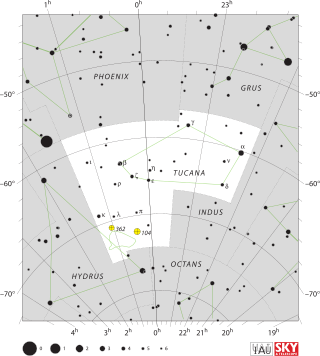
Tucana is a constellation of stars in the southern sky, named after the toucan, a South American bird. It is one of twelve constellations conceived in the late sixteenth century by Petrus Plancius from the observations of Pieter Dirkszoon Keyser and Frederick de Houtman. Tucana first appeared on a 35-centimetre-diameter (14 in) celestial globe published in 1598 in Amsterdam by Plancius and Jodocus Hondius and was depicted in Johann Bayer's star atlas Uranometria of 1603. French explorer and astronomer Nicolas Louis de Lacaille gave its stars Bayer designations in 1756. The constellations Tucana, Grus, Phoenix and Pavo are collectively known as the "Southern Birds".
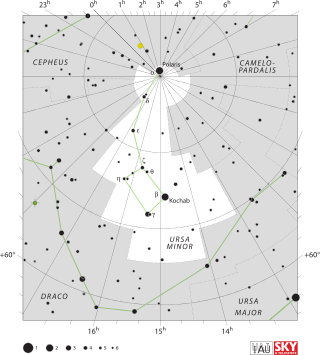
Ursa Minor, also known as the Little Bear, is a constellation located in the far northern sky. As with the Great Bear, the tail of the Little Bear may also be seen as the handle of a ladle, hence the North American name, Little Dipper: seven stars with four in its bowl like its partner the Big Dipper. Ursa Minor was one of the 48 constellations listed by the 2nd-century astronomer Ptolemy, and remains one of the 88 modern constellations. Ursa Minor has traditionally been important for navigation, particularly by mariners, because of Polaris being the north pole star.
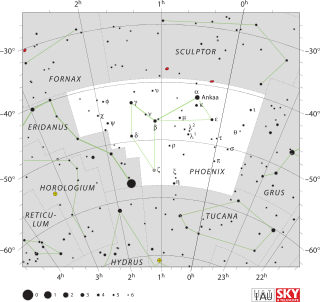
Phoenix is a minor constellation in the southern sky. Named after the mythical phoenix, it was first depicted on a celestial atlas by Johann Bayer in his 1603 Uranometria. The French explorer and astronomer Nicolas Louis de Lacaille charted the brighter stars and gave their Bayer designations in 1756. The constellation stretches from roughly −39° to −57° declination, and from 23.5h to 2.5h of right ascension. The constellations Phoenix, Grus, Pavo and Tucana, are known as the Southern Birds.

Coma Berenices is an ancient asterism in the northern sky, which has been defined as one of the 88 modern constellations. It is in the direction of the fourth galactic quadrant, between Leo and Boötes, and it is visible in both hemispheres. Its name means "Berenice's Hair" in Latin and refers to Queen Berenice II of Egypt, who sacrificed her long hair as a votive offering. It was introduced to Western astronomy during the third century BC by Conon of Samos and was further corroborated as a constellation by Gerardus Mercator and Tycho Brahe. It is the only modern constellation named for a historic person.

Norma is a small constellation in the Southern Celestial Hemisphere between Ara and Lupus, one of twelve drawn up in the 18th century by French astronomer Nicolas-Louis de Lacaille and one of several depicting scientific instruments. Its name is Latin for normal, referring to a right angle, and is variously considered to represent a rule, a carpenter's square, a set square or a level. It remains one of the 88 modern constellations.

Cassiopeia is a constellation and asterism in the northern sky named after the vain queen Cassiopeia, mother of Andromeda, in Greek mythology, who boasted about her unrivaled beauty. Cassiopeia was one of the 48 constellations listed by the 2nd-century Greek astronomer Ptolemy, and it remains one of the 88 modern constellations today. It is easily recognizable due to its distinctive 'W' shape, formed by five bright stars.

Crater is a small constellation in the southern celestial hemisphere. Its name is the latinization of the Greek krater, a type of cup used to water down wine. One of the 48 constellations listed by the second-century astronomer Ptolemy, it depicts a cup that has been associated with the god Apollo and is perched on the back of Hydra the water snake.

Circinus is a small, faint constellation in the southern sky, first defined in 1756 by the French astronomer Nicolas-Louis de Lacaille. Its name is Latin for compass, referring to the drafting tool used for drawing circles. Its brightest star is Alpha Circini, with an apparent magnitude of 3.19. Slightly variable, it is the brightest rapidly oscillating Ap star in the night sky. AX Circini is a Cepheid variable visible with the unaided eye, and BX Circini is a faint star thought to have been formed from the merger of two white dwarfs. Two sun-like stars have planetary systems: HD 134060 has two small planets, and HD 129445 has a Jupiter-like planet. Supernova SN 185 appeared in Circinus in 185 AD and was recorded by Chinese observers. Two novae have been observed more recently, in the 20th century.

Horologium is a constellation of six stars faintly visible in the southern celestial hemisphere. It was first described by the French astronomer Nicolas-Louis de Lacaille in 1756 and visualized by him as a clock with a pendulum and a second hand. In 1922 the constellation was redefined by the International Astronomical Union (IAU) as a region of the celestial sphere containing Lacaille's stars, and has since been an IAU designated constellation. Horologium's associated region is wholly visible to observers south of 23°N.

Pegasus is a constellation in the northern sky, named after the winged horse Pegasus in Greek mythology. It was one of the 48 constellations listed by the 2nd-century astronomer Ptolemy, and is one of the 88 constellations recognised today.




